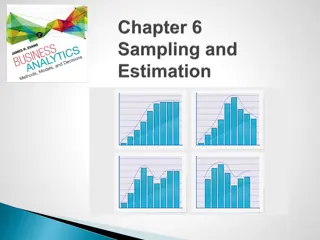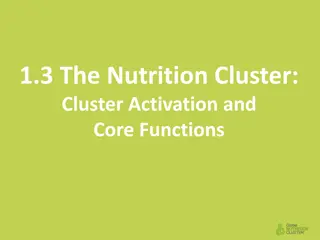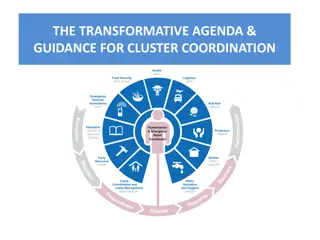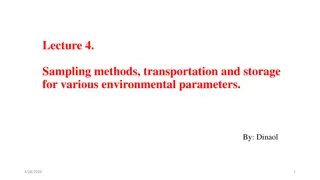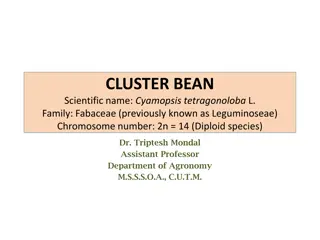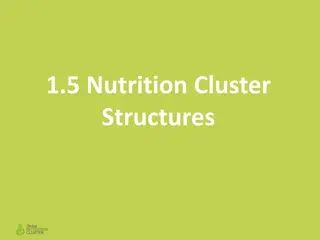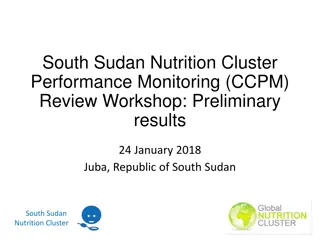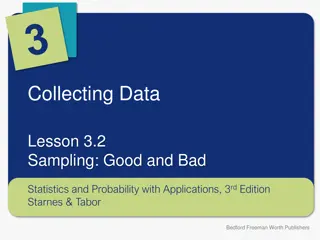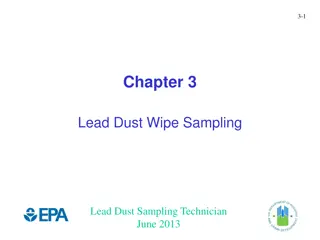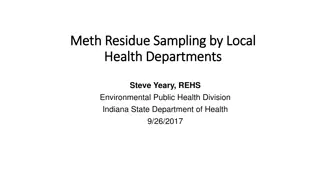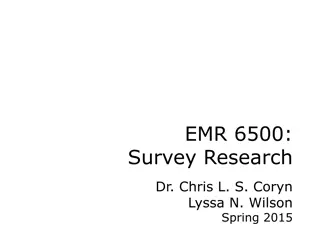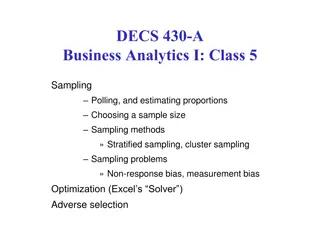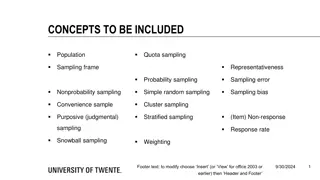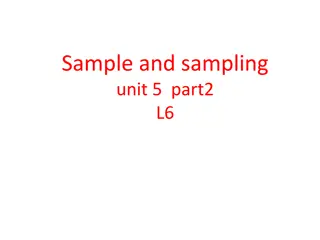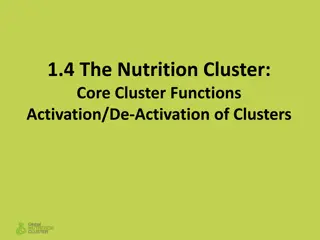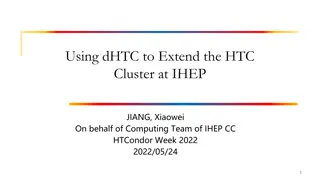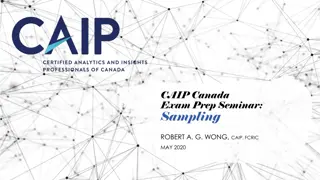Understanding Sampling Methods in Social Research
Sampling in social research involves selecting a subset of a population to make inferences about the whole. It helps in saving time and money, ensures accuracy in measurements, and allows estimation of population characteristics. The key principles of sampling include systematic selection, clear def
1 views • 19 slides
Understanding Sampling Methods in Statistical Analysis
Sampling is a crucial process in statistical analysis where observations are taken from a larger population. Different sampling techniques are used based on the analysis being performed. Sampling methods help in studying populations when studying the entire population is not feasible. There are two
0 views • 8 slides
Mine Action in the Humanitarian Cluster System
The Inter-Agency Standing Committee (IASC) plays a crucial role in coordinating humanitarian efforts, with a focus on mine action in the global protection cluster. This involves clear responsibilities, strategic planning, and advocacy to address humanitarian needs. The IASC Reference Module for Clus
3 views • 18 slides
Sampling Under the RRF - General Principles and Methods
Sampling under the RRF is essential for the Commission to ensure reasonable assurance of fulfillment of numerical milestones or targets. The approach involves statistical risk-based random sampling with specific thresholds and considerations for different types of milestones. Various statistical tab
0 views • 12 slides
Understanding Non-Probability Sampling Methods
Non-probability sampling methods involve selecting samples based on subjective judgment rather than random selection. Types include convenience sampling, quota sampling, judgmental (purposive) sampling, and snowball sampling. Convenience sampling picks easily available samples, quota sampling select
2 views • 7 slides
Wood Innovation Cluster: Driving Regional Growth and Development in the Wood Industry
The Wood Innovation Cluster, established in 2018 in Skellefte municipality, brings together key stakeholders in the wood industry to foster regional growth and development. It coordinates research, development, education, and testing activities while promoting sustainable procurement. Through collab
0 views • 4 slides
Systematic Analysis of Real Samples in Analytical Chemistry
This analysis covers the systematic process involved in analyzing real samples, including sampling, sample preservation, and sample preparation. It discusses the importance of accurate sampling in obtaining information about various substances, such as solids, liquids, gases, and biological material
0 views • 54 slides
Understanding Sampling Plans in Statistical Analysis
Sampling is vital for statistical analysis, with sampling plans detailing objectives, target populations, operational procedures, and statistical tools. Different sampling methods like judgmental, convenience, and probabilistic sampling are used to select samples. Estimation involves assessing unkno
1 views • 36 slides
Inter-Cluster Coordination and Information Management in Humanitarian Emergencies
Inter-Cluster Coordination and Information Management play vital roles in humanitarian emergencies. The coordination mechanism involves regular meetings convened by the RC/HC and coordinated by OCHA, providing opportunities for clusters to collaborate on shared planning, needs assessments, and poole
3 views • 13 slides
Introduction to Sampling in Statistics
Sampling in statistics involves selecting a subset of individuals from a population to gather information, as it is often impractical to study the entire population. This method helps in estimating population characteristics, although it comes with inherent sampling errors. Parameters represent popu
2 views • 24 slides
Understanding the Nutrition Cluster Activation and Core Functions
Exploring Level 3 emergencies, the process of cluster activation and deactivation, and the core functions of the Nutrition Cluster at the country level. Learn about the criteria for cluster activation, gaps in response, and the strategic approach to humanitarian system-wide emergency activation. Dis
3 views • 21 slides
Understanding Sampling Methods and Errors in Research
Sampling is crucial in research to draw conclusions about a population. Various methods like simple random sampling, stratified sampling, and systematic sampling help in selecting representative samples. Sampling error arises due to differences between sample and population values, while bias leads
0 views • 12 slides
Transformative Agenda and Guidance for Effective Cluster Coordination
Explore the transformative agenda and guidance for cluster coordination, emphasizing the roles of UNICEF as a cluster lead agency, core cluster functions, inter-cluster coordination, and management strategies for effective humanitarian response. Key focus areas include accountability, human financin
1 views • 19 slides
Fundamentals of Food Sampling and Analysis
Discover the key methods and procedures for sampling, transportation, and storage of environmental parameters, focusing on food sampling and analysis. Explore the importance of representative samples, quality analysis results, and risks associated with sampling. Learn about homogeneous vs. heterogen
5 views • 36 slides
Overview of Cluster Bean (Cyamopsis tetragonoloba L.) - Uses, Distribution, and Classification
Cluster beans, scientifically known as Cyamopsis tetragonoloba L., are valuable leguminous crops with economic importance due to their drought tolerance and industrial applications, particularly in gum production. They are cultivated for feed, fodder, and vegetable purposes, with their seeds rich in
5 views • 14 slides
Sub-national Nutrition Cluster Coordination Training Workshop
Welcome to the Sub-national Nutrition Cluster Coordination Training Workshop aimed at sharing key concepts, tools, and approaches for effective coordination of nutrition in emergencies. This training prepares participants for working in Nutrition Cluster/Sector Coordination, promoting dialogue and s
1 views • 10 slides
Understanding Nutrition Cluster Structures and Roles
Learn about the structures and roles within Nutrition Clusters at different levels, including the responsibilities of key actors such as the Cluster Coordinator, Information Manager, Strategic Advisory Group, and Technical Working Groups. Explore the involvement of governmental and non-governmental
0 views • 27 slides
Sampling Methods and Techniques
Learn about the differences between stratified random sampling and cluster sampling techniques, their advantages, and how to implement them effectively in surveys and data collection. Understand the importance of selecting a sample that accurately represents the population being studied, and discove
0 views • 14 slides
Review of South Sudan Nutrition Cluster Performance Monitoring Workshop
Preliminary results from the South Sudan Nutrition Cluster Performance Monitoring (CCPM) Review Workshop held in Juba, Republic of South Sudan on 24th January 2018. The workshop aimed to ensure efficient coordination, identify areas for improvement, raise awareness of support needed, and strengthen
0 views • 18 slides
Understanding Sampling and Signal Processing Fundamentals
Sampling plays a crucial role in converting continuous-time signals into discrete-time signals for processing. This lecture covers periodic sampling, ideal sampling, Fourier transforms, Nyquist-Shannon sampling, and the processing of band-limited signals. It delves into the relationship between peri
1 views • 60 slides
Understanding Biases in Sampling Methods
Statistical studies rely on samples to draw conclusions about populations, but the method of sampling can introduce biases. This text discusses convenience sampling, voluntary response sampling, random sampling, and the implications of biased sampling methods on study results. It highlights how bias
1 views • 12 slides
Guide to Environmental Surface Sampling Techniques
Understanding the importance of environmental surface sampling is crucial for ensuring hygiene and safety. This guide covers key aspects such as pre-sampling considerations, aseptic techniques, major sampling methods like RODAC plate, swab, and wipe methods, along with detailed procedures for each m
1 views • 16 slides
Lead Dust Wipe Sampling Techniques and Guidelines
This resource provides valuable information on lead dust wipe sampling techniques for Lead Dust Sampling Technicians. It covers the objectives, measuring lead dust, sampling strategy, sampling locations based on EPA RRP Rule, and HUD clearance regulations. Techniques for taking dust wipe samples, id
2 views • 41 slides
Comprehensive Guidelines for Meth Residue Sampling by Local Health Departments
This detailed guide outlines the procedures and protocols for meth residue sampling conducted by local health departments. It covers the reasons for sampling, the importance of qualified inspectors, testing methodologies, sampling kits assembly, and more. Key points include when and why sampling is
0 views • 19 slides
Understanding Sampling in Survey Research
This content covers essential concepts of survey research, statistics, and sampling methods. It delves into elements of the sampling problem, technical terms, and how to select a sample for surveys. The discussions revolve around population parameters, sampling procedures, and the control of informa
1 views • 39 slides
Understanding Sampling in Social Research Methods
Sampling in social research involves selecting a portion of a population to draw conclusions about the entire group. It helps save time, money, and allows for accurate measurements. The key principles of sampling include systematic selection, clear definition of sample units, independence of units,
0 views • 19 slides
Understanding Non-Probability Sampling Methods
Non-probability sampling involves selecting samples based on subjective judgment rather than random selection, leading to a lack of equal chances for all population members to participate. Various types include convenience sampling, quota sampling, judgmental sampling, and snowball sampling. Conveni
1 views • 7 slides
Understanding Sampling in Artificial Intelligence: An Overview
Exploring the concept of sampling in artificial intelligence, particularly in the context of Bayesian networks. Sampling involves obtaining samples from unknown distributions for various purposes like learning, inference, and prediction. Different sampling methods and their application in Bayesian n
2 views • 29 slides
Approximate Inference in Bayes Nets: Random vs. Rejection Sampling
Approximate inference methods in Bayes nets, such as random and rejection sampling, utilize Monte Carlo algorithms for stochastic sampling to estimate complex probabilities. Random sampling involves sampling in topological order, while rejection sampling generates samples from hard-to-sample distrib
0 views • 9 slides
Understanding Sampling Methods in Business Analytics
Sampling plays a crucial role in estimating proportions and making informed decisions in business analytics. From polling to estimating proportions, this class explores sampling techniques, sample size determination, and potential biases. Learn about choosing a sample size, stratified and cluster sa
2 views • 23 slides
State Crime Lab Drug Sampling Protocols
Using the State Crime Lab's drug sampling protocols for defense involves understanding three sampling methods: administrative sample selection, threshold sample selection, and hypergeometric sampling plan. The hypergeometric plan allows experts to make assumptions about the chemical composition of u
0 views • 30 slides
Nutrition Cluster Partnership Essentials
Discover the minimum commitments for engaging in the Nutrition Cluster, learn about partnership principles, and understand how these guide collaborative efforts within the cluster. Explore partner commitments, principles of partnership, and engage in an exercise to apply these concepts practically.
0 views • 7 slides
Exploring the Social Change & Campaigning Learning Cluster
This slide deck explores the Social Change & Campaigning Learning Cluster conducted by the Sheila McKechnie Foundation. It delves into the aims of the cluster, participants, new skills acquired, and next steps. The learning clusters were designed to go beyond one-day events, providing residents with
0 views • 29 slides
Understanding Sampling Variability in Statistical Analysis
Random sampling is crucial in statistical analysis to minimize sampling error. Sampling variability occurs due to chance when a random sample is surveyed instead of the entire population. Different units selected can lead to slightly varied estimates. It's important to understand and address samplin
1 views • 31 slides
Understanding Non-Probability Sampling Methods
Non-probability sampling involves selecting samples based on subjective judgement rather than random selection. This method may not give all population members an equal chance to participate. Types include convenience sampling, quota sampling, judgemental sampling, and snowball sampling.
0 views • 7 slides
Understanding Sampling Methods in Research
Explore key concepts in sampling such as probability and non-probability methods, sampling error, representativeness, and types of biases. Learn about the importance of sampling in research, theoretical variables, conceptualization, and operationalization. Evaluate different types of sampling proces
1 views • 20 slides
Understanding Non-Probability Sampling Techniques in Nursing Research
Non-probability sampling in nursing research involves selecting samples subjectively rather than randomly. This sampling method carries a higher risk of bias and limits statistical inference about the entire population. Five main types include convenience, purposive, quota, snowball, and voluntary r
0 views • 30 slides
Nutrition Cluster Core Functions and Activation Strategies
The Nutrition Cluster aims to support service delivery, inform strategic decision-making, and plan and implement cluster strategies to address the needs and priorities of affected populations. Core functions include supporting service delivery, advocacy, capacity-building, and monitoring and evaluat
0 views • 19 slides
Extending IHEP's HTC Cluster Using dHTC
IHEP is extending its HTC cluster to accommodate the data processing needs of over 15 experiments in the field of high energy physics. The motivation behind this expansion includes the need for more resources, existing data processing limitations, and user preferences for local analysis. The cluster
0 views • 21 slides
Understanding Sampling: Importance, Process, and Errors Explained
This content delves into the world of sampling, exploring why sampling is crucial, the sampling process involving defining populations and calculating sample sizes, and the distinction between non-sampling and sampling errors. It covers the significance of representative samples, common errors in sa
0 views • 15 slides







